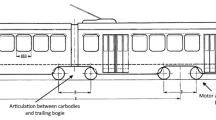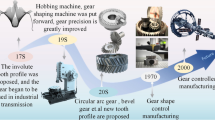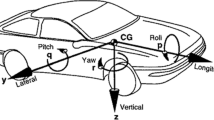Abstract
In the crane industry, the sizing of hoisting machinery is based on several factors, including the weight of the load being lifted, the frequency of the duty cycles, the speed at which the lifting is done, and the method of rope reeving. Industrial cranes, such as those used in the Paper, Automotive, Steel, and Power industries, often utilize hoists with a true vertical lift rope reeving method that employs both left-handed and right-handed ropes. The rope drum is a key component that plays a crucial role in determining the size of the hoisting gear. International design standards, such as FEM, EN, and CMAA, govern the dimensioning of the rope drum. These design standards not only confirm the strength of the drum tube but also provide guidance on the maximum permissible fleet angle for ropes leaving the drum. This paper presents the development of an active rope guide that aims to create zero-degree drum angles, thus activating the area of use that is typically forbidden by crane standards. To test this concept, a prototype was built.





























Similar content being viewed by others
Abbreviations
- ARG:
-
Active rope guide
- C :
-
Distance between guiding sheaves in ARG and hook block sheaves (mm)
- d :
-
Rope diameter (mm)
- D :
-
Rope drum pitch diameter (mm)
- EOT:
-
Electric overhead traveling
- H:
-
Distance between guiding sheaves and top of hook block (mm)
- HOL:
-
Height of lift (mm)
- P :
-
Drum groove pitch (mm)
- PLC:
-
Programmable Logic Controller
- SWL:
-
Safe working load (ton)
- T:
-
Rope travel on drum (mm)
- TVL:
-
True vertical lift
- \(\eta_{reev}\) :
-
Reeving efficiency
- i rope :
-
Reeving ratio or mechanical advantage
- T drum :
-
Drum torque (kN m)
- F h :
-
Guiding force (N)
- α :
-
Angle of the grooves on the drum (°)
- \(\beta_{L}\) and \(\beta_{R}\), ϕ, ν :
-
Fleet angles on the pulley (°)
- \(\beta_{L} + \alpha\) and \(\beta_{R} - \alpha\) :
-
Fleet angles on the drum (°)
- P_angle:
-
Pitch angle of groove (°)
- F_angle:
-
Fleet angle (°)
- R_angle:
-
Rope angle (°)
- X_up:
-
Rope distance in up position (mm)
- X_low:
-
Rope distance in lower position (mm)
References
K.D. Harsukhlal, A review on design and analysis of hoisting machinery in EOT crane. Int. J. Sci. Res. Dev. 3, 1161–1164 (2015)
H. Mouradi, A. El Barkany, A. El Biyaali, Steel wire ropes failure analysis: experimental study. Eng. Fail. Anal. 91, 234–242 (2018). https://doi.org/10.1016/j.engfailanal.2018.04.019
EN 13001-3-2:2014, Cranes—General design—Part 3-2: Limit States and proof of competence of wire ropes in reeving systems
FEM 1.001:1998, Rules for the design of hoisting appliances, booklets 1, 2, 3, 4, 5, 8 and 9
CMAA Specification No. 70-2020, Multiple Girder Cranes
K. Feyrer, Wire Ropes: Tension, Endurance, Reliability (Springer, Berlin, 2007), p.1–59
P. Palit, S.K. Kushwaha, J. Mathur, A.K. Chaturvadi, Life cycle assessment of wire rope used in crane application in a steel plant. J. Fail. Anal. Prev. 19, 752–760 (2019). https://doi.org/10.1007/s11668-019-00655-5
M. Matejic, M. Blagojevic, V. Marjanovic, R. Vujanac, B. Simić, Tribological aspects of the process of winding the steel rope around the winch drum. Tribol. Ind. 36, 90–96 (2014)
R. Mitrović, D. Momčilović, I. Atanasovska, N. Hut, Service life prediction of running steel wire ropes. Struct. Integr. Life. 10(3), 199–202 (2010)
O. Yusuf, C. İmrak, Experimental determination of degradation influence on bending over sheave fatigue life of steel wire ropes. Indian J. Eng. Mater. Sci. 20, 14–20 (2013)
Schwake J.S. (1999) An improved groove design for wire rope drums and sheaves, Patent No. CA2287676A1
G. Vukelic, G. Vizentin, Damage-induced stresses and remaining service life predictions of wire ropes. Appl. Sci. 7, 107 (2017). https://doi.org/10.3390/app7010107
Y. Fei, J. Jiang, C. Sun, Analysis of the influence on the hydraulic lifting circuit of the boom crane when the characteristics of the steel wire rope changes. IOP Conf. Ser. Mater. Sci. Eng. 1009, 012021 (2021). https://doi.org/10.1088/1757-899X/1009/1/012021
Z.H. Hu, J.Q. Hu, The fatigue and degradation mechanisms of wire ropes bending-over-sheaves. AMM. 127, 344–349 (2011). https://doi.org/10.4028/www.scientific.net/AMM.127.344
X. Chang, X. Chen, Y. Dong et al., Friction and wear behavior between crane wire rope and pulley under different contact loads. Lubricants. 10, 337 (2022). https://doi.org/10.3390/lubricants10120337
W. Kacalak, Z. Budniak, M. Majewski, Modelling and analysis of the positioning accuracy in the loading systems of mobile cranes. Materials. 15, 8426 (2022). https://doi.org/10.3390/ma15238426
Joseph Ransom Kallio-Myers (2020) Optimization of rope sheave groove profile to improve synthetic rope lifetime. Bachelor’s thesis, HAMK University of Applied Sciences
P. Peterka, J. Krešák, S. Kropuch et al., Failure analysis of hoisting steel wire rope. Eng. Fail. Anal. 45, 96–105 (2014). https://doi.org/10.1016/j.engfailanal.2014.06.005
L. Yan, G. Cao, N. Wang, J. Li, Lateral stiffness and deflection characteristics of guide cable with multi-boundary constraints. Adv. Mech. Eng. 9, 168781401771107 (2017). https://doi.org/10.1177/1687814017711079
C.R. Chaplin, Failure mechanisms in wire ropes. Eng. Fail. Anal. 2, 45–57 (1995). https://doi.org/10.1016/1350-6307(95)00004-A
P. Neumann, Investigations into the influence of tribological stress on wire rope damage, in particular wear and tear, taking into account steelworks-specific operating conditions. Dissertation TH Aachen (1987)
S. Schönherr, Influence of the fleet angle on the service life of wire ropes running over sheaves. Diss. Universitüat, Stuttgart (2005) http://elib.uni-stuttgart.de/handle/11682/4070
Maintenance and adjustment of the Rope guide. https://blog.demagcranes.com/en-us/maintaining-your-demag-dh-wire-rope-hoist-maintenance-and-adjustment-of-the-rope-guide/
EN 14492-2:2019, Cranes. Power driven winches and hoists. Part 2: Power driven Hoists
Demag Cranes & Components GmbH, US Patent US5829737A, Rope guide for a winch having two interconnected drivable rope guides
EN 13135:2013+A1:2018, Cranes – Safety – Design – Requirements for equipment
Minimum breaking load of 6x36-IWRC ropes. https://www.steelwirerope.com/WireRopes/Galvanised/6x36-IWRC-wire-rope.html
DIN 867: 1974, Basic Rack of Cylindrical Gears with Involute Teeth for General and Heavy Engineering
R.G. Budynas, J.K. Nisbett, J.E. Shigley, Shigley’s Mechanical Engineering Design, 8th edn. (McGraw-Hill, New York, 2011)
Acknowledgments
The authors would like to acknowledge Konecranes Finland for the funding, test facilities and resources to carry out this prototype test. A special thanks to Mr. Jari Kaiturinmäki and Mr. Jari Jalkanen for their guidance and support during the project.
Funding
This work was funded by Konecranes Finland.
Author information
Authors and Affiliations
Corresponding author
Ethics declarations
Conflict of interest
The authors declare that they have no conflict of interest.
Additional information
Publisher's Note
Springer Nature remains neutral with regard to jurisdictional claims in published maps and institutional affiliations.
Rights and permissions
Springer Nature or its licensor (e.g. a society or other partner) holds exclusive rights to this article under a publishing agreement with the author(s) or other rightsholder(s); author self-archiving of the accepted manuscript version of this article is solely governed by the terms of such publishing agreement and applicable law.
About this article
Cite this article
Dhande, D.Y., Ahluwalia, V. Development of an Active Rope Guide to Generate Zero-Degree Drum Angles for True Vertical Lift Hoists. J Fail. Anal. and Preven. 23, 1001–1025 (2023). https://doi.org/10.1007/s11668-023-01639-2
Received:
Accepted:
Published:
Issue Date:
DOI: https://doi.org/10.1007/s11668-023-01639-2




